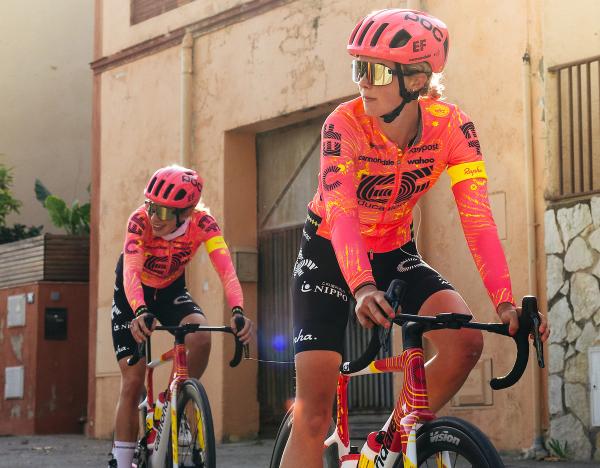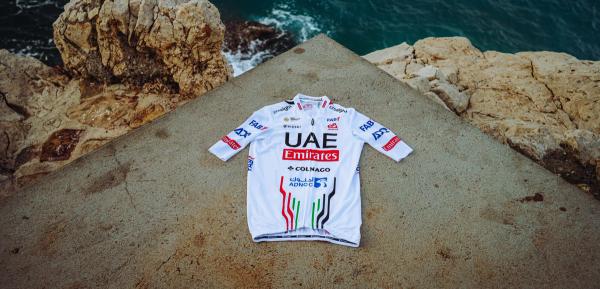How are WorldTour cycling kits designed?
GCN spoke exclusively to designers and teams to understand more about the design process behind a jersey fit for the WorldTour
Pete Trifunovic
Digital Content Creator
© cyclingmedia_agency / Soufal Quick-Step / Getty Images / Visma-Lease a bike
Some of the freshest WorldTour kits for 2024 from Visma-Lease a Bike, Soudal Quick-Step and Intermarché-Wanty
New WorldTour jersey designs are released - or leaked - at a trickle pace over the winter months, with some arriving as early as November while others don’t get seen in public until the first race days of the year at the men's and women's Tours Down Under.
It's almost like a prolonged version of unwrapping presents on Christmas day. You’ll get a few genuine surprises; some good, but expected gifts that you probably asked for; a couple of stocking fillers (like that deodorant set you've still not touched) that never seem to change year-on-year; and maybe one or two items where you’re politely asking if they’ve kept the receipt.
Nonetheless, there’s always an air of excitement surrounding kit releases. After all, it signals the start of a new season of racing and the rollercoaster that is professional cycling.
Read more:
- Primož Roglič and others show off their new 2024 team kits
- Ineos Grenadiers reveal new GOBIK kit for 2024
- EF Pro Cycling reveal new Rapha kit for 2024
It also gives rise to the annual ranking, rating and critiquing of the new attire by almost every fan, social media influencer and pundit around.
Plenty have opinions on what makes a kit good, whether it be the colour scheme chosen, the patterns picked or how the sponsors look – and let’s not even get started on national champion jersey designs.
However, do many actually consider, or know about the steps involved in making a jersey fit for a team in the men’s or women’s WorldTour?
GCN spoke exclusively to those at the heart of the process to get to grips with it and potentially understand why every team doesn’t just choose the wildest concept kit out there.
A lengthy and long-winded process
While the off-season is the time of year most associated with kit launches, the design process can begin as early as the Spring, admits Stijn Dossche, founder of stycle.design.
The Belgian designer, who has created the jerseys for Israel Premier-Tech, Intermarché-Wanty and most recently, Soudal Quick-Step was on holiday in Guatemala when he agreed to work with Patrick Lefevere’s squad for their new strip.
“I had a video call in a hostel with some shitty Wi-Fi to close one of the biggest deals I’ve ever done. It started in May and they wanted to have things done around August,” revealed Dossche.
Read more: Julian Alaphilippe lip syncs to Céline Dion in Soudal Quick-Step kit unveil
While the process can take up to a few months from start to finish, creating the jersey design isn’t always the most time-consuming aspect, despite what many may think.
Rick van Mechelen, the senior graphic designer at AGU, kit manufacturer for Visma-Lease a Bike, and our own GCN Pro Team Kit, explains the process succinctly when he states: “It’s not that the designing takes especially long but for instance all the centimetres on all the logos [need checking]. So we send our design to the team, and they send it to all their sponsors and that might take some time before everybody looks at it and gives it a go. It takes a few months actually.”
The Amsterdam-based creative also highlighted the extent of the operation that a new kit design takes for a manufacturer. While many just think about the fresh jersey, there are around 70 different products for AGU to refresh with the new year’s sponsors and detailing, from long sleeve jackets and vests to wind capes and bidons.

© Visma-Lease a bike
Wout van Aert in the new Visma-Lease a bike kit designed by AGU
Providing an insight into the technical side of producing jerseys and other clothing, Van Mechelen adds: “A lot of people forget that every single piece of textile is done by hand, some people think that it rolls out of a machine. The stitching is all blind so the stitching is on the inside.”
Yet despite the level of detail involved, a kit will likely look different depending on who’s wearing it.
Using a team presentation as an example of where this is easy to spot, Van Mechelen explained: “You see the sprinters and [next to them] the mountain specialists - their legs are a little bit thinner. The sprinters have very thick legs and what happens is because most of the team kits are printed on white, there is a colour difference and you really see that in the bib shorts. So the bibs of Mathieu van der Poel look very different to the guy next to him.”
Jersey design and sponsor visibility is a continual trade-off
While Dossche and Van Mechelen work within very different setups, they both agree that fewer sponsors create a smoother process and outcome. The latter uses Movistar with their large ‘M’ and Team Sky as prime examples of this.
“Cycling sometimes has more conservative sponsors and they want [a kit] where their logo looks best and not the kit that looks best,” Dossche admitted.
Adding: “I can understand [why], but sometimes you can maybe get more screen time or a kit going more viral on social media with a better kit [design].”
Of course, sponsorships form the backbone of the sport’s funding and doing away with them would be like turkeys calling for Christmas, so a compromise has to be found.
Maxime Segers, Intermarché-Wanty’s chief operating officer highlights the continuing battle for balance in this area.
“It's always nicer and more beautiful for the fans to have a jersey with one name sponsor, nice colours around it and to try to find the best design but in our case, this is a balance and a mix that we have to find every year: between finding a new design which is attractive and offering the best visibility to every sponsor,” he explained.

© cyclingmedia_agency
The new Intermarché-Wanty kit for 2024
While the designers may view it as a more complex task, Segers believes that Intermarché-Wanty’s business model which relies on two named sponsors and several smaller partners, allows the team greater freedom in their jersey design and colour scheme.
“In our case, it's not mandatory [to use a certain colour] because we can explain to the sponsors [that] due to the business model, we try to find a balance and have a neutral colour that we can use year after year as a base.
“Of course, we’ve had these colours for seven years now and the team is recognisable so that’s always nice for the sponsors to be able to easily find and locate the riders in the bunch.
“The fact is we don't have one sponsor giving us 95% of the budget” Segers continued, explaining why they don’t need to use the brand colours of one of their key sponsors.
A peloton full of colour
The colours Segers refers to are the fluorescent yellow and navy tones that help Intermarché-Wanty stand out in a bunch that is more often than not a kaleidoscope of colours.
Read more: Pro cycling kits 2024: What the WorldTour teams are wearing
A team’s kit can be just as important as a name in forming a team’s brand image or representing their ‘DNA’, the WorldTour team COO admits.
Van Mechelen came across a similar challenge when Jumbo stepped down as a key sponsor for the Dutch squad this year, taking their deep yellow colour scheme with them.
“The team wanted to keep yellow but they could not use the same yellow as Jumbo’s yellow, because that refers too much to the old sponsor. So they chose a new yellow.
“I wish they would have chosen blue or red because commercially it would be more interesting for us but it's in their guidelines and their DNA,” he admits honestly.
Once set on a colour though, and with all the sponsors placed into position, a design pattern is the only other element required.
Both Bossche and Van Mechelen initially create a wide variety of designs for their clients, some down-the-line and simple, others left-field and vibrant.
For stycle.design, his briefs are typically relaxed: “They just say ‘use these colours and just have fun with it!’”
With limited edition strips, there might be a more specific idea to convey, like Israel Premier-Tech’s Tour de France jersey in 2022 which took inspiration from the team’s Racing for Change project that aimed to develop Rwanda’s next generation of cyclists.

© Velo Collection (TDW) / Getty Images
Hugo Houle celebrates winning stage 16 of the 2022 Tour de France
For Intermarché, whom Dossche has worked with since 2021, he bases his ideas around “cool patterns, design ideas or just casual garments.”
He continued: “I maybe learned to not give them all the conservative designs [first] but the more wild designs, to keep some relaxed ones [as a backup].
“Every team is different but most of the time I already have some kind of gut feeling [about whether a design will be well received or not],” Dossche admits in regards to pitching his array of designs.
Whether it be the eye-catching designs of EF Pro Cycling and FDJ-SUEZ, or the tried-and-tested classics of Movistar and UAE Team Emirates, the 2024 women's and men's WorldTour pelotons will once more be a melting pot of the world's best designers.
With every year, seemingly ever more fans crave the bold tones of brightly-coloured kits, with outlandish patterns that wouldn't go amiss at an abstract art show. But whilst some teams lean into this trend with aplomb, it is always worth remembering that the pragmatic manufacturing expertise of a creator like Van Mechelen may have a good reason for winning out.
“Not everything that you can do on the internet, you can transfer to textile because it's different materials to print on.”
















